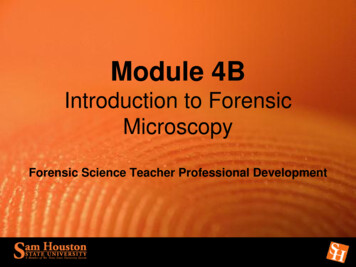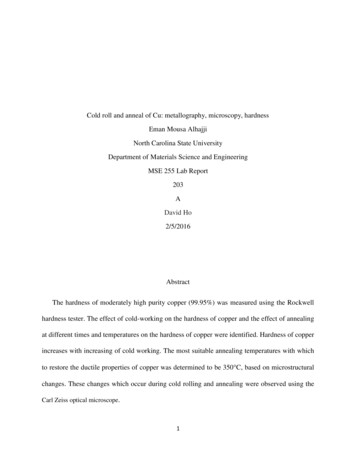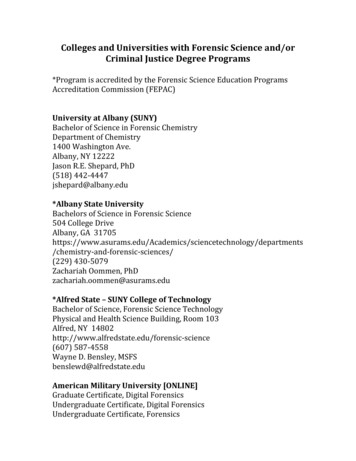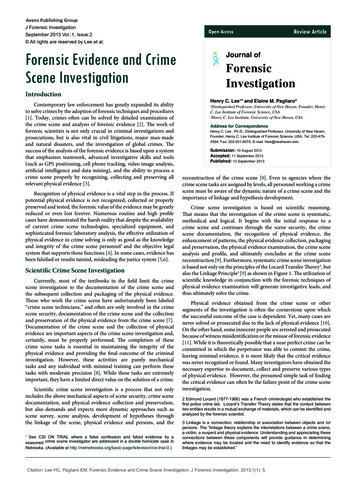
Transcription
Module 4BIntroduction to ForensicMicroscopyForensic Science Teacher Professional Development
Part 2 Introduction to Forensic MicroscopyThere are several steps in the process ofrecovery and examination of trace evidence:1. Detection2. Isolation3. Identification4. Comparison5. Evaluation
Part 2 Introduction to Forensic Microscopy1) Detection of trace evidence is usually achieved by observationsof crime scene investigators at a scene of crime or by a traceanalyst in the crime laboratory.Magnifiers, stereomicroscopes with an alternate light source, arealways used to facilitate the discovery and detection of traceevidence from a crime scene or from an object.Figure 3 A regular view ofthe keyboard of a laptopFigure 4 A shaft of hair can bebetter discovered under this macroview of the keyboard.
Part 2 Introduction to Forensic Microscopy In Figure 3 and Figure 4, a hair can be betterobserved under a macro view of thekeyboard. Since trace evidence is often invisible to thenaked eye, it can be better detected under amacro view. The crime scene investigator or traceanalyst should bring his or her eyes closer tothe object with bright lights (or alternate lightsources) at the stage of trace evidencedetection (or evidence search).
Part 2 Introduction to Forensic MicroscopySimilar examples can be seen in Figure 5 and Figure 6. Witha macro view, the observer can recognize more details of theobject.Figure 5 A regular view of theobjects on a tableFigure 6 A macro view of theobjects on a table
Part 2 Introduction to Forensic Microscopy2) Isolation (physical removal) of trace from asubstrate can be carefully performed with toolslike tweezers, scalpels, or needles under astereomicroscope, once the trace is detected.3) Identification occurs through physical andchemical methods, after targeted traceevidence is isolated from a substrate.Generally, least destructive analytical methodsshould be performed first before destructivemethods.
Part 2 Introduction to Forensic Microscopy4) Comparisons between known samples andquestioned samples can then be performedbased on the results from the physicalexamination and the chemical analysis of thesamples.5) Evaluation occurs to determine the locationof the trace evidence, the origin of themanufacturer, and its end-use. Uniqueinformation can be generated as aninvestigative lead.
Part 2 Introduction to Forensic Microscopy Microscopic examination of trace evidence isthe fast and affordable way to identify andcompare trace evidence. A microscope is the most fundamental toolin a trace laboratory. Microscopic examination of trace evidence isusually performed with a stereomicroscopefollowed by a compound light microscope. Optical properties, such as refractive indexand birefringence, can be readily determinedby the use of a polarized light microscope(PLM).
Part 2 Introduction to Forensic MicroscopyTo learn the fundamentals of microscopy, a visit to thefollowing website is ex.html
Part 2 Introduction to Forensic MicroscopyFundamental properties of light and color include the following: Electromagnetic property oflight Particle property of light Wave property of light Sources of visible light Fluorescence Speed of light Reflection of light Refraction of light Diffraction of light Polarization of light Interference of light Optical birefringence Color temperature Light filters Human vision and colorperception Light and energy Lenses and geometricaloptics Basic properties of mirrors Prisms and beam splitters Laser light sources
Part 2 Introduction to Forensic MicroscopyReview these links:1. What is a omy/introduction.html
Part 2 Introduction to Forensic MicroscopyReview these links:2. What is Köhler atomy/kohler.html
Part 2 Introduction to Forensic MicroscopyReview these links:3. What is a es/stereomicroscopy/stereointro.html
Part 2 Introduction to Forensic MicroscopyReview these links:4. Microscope: Basics and Beyond (50 pages in PDF format;20.7 ndbeyond.pdf
Part 2 Introduction to Forensic MicroscopyReview these links:5. 50 Most Frequently Asked Questions About r/faq.html
Part 2 Introduction to Forensic MicroscopyTechniques of microscopy, such as Bright fieldDark fieldDifferential Interference Contrast (DIC)FluorescencePhase contrastPolarized lightThese can also be found on the listed websitesand reading assignment.
Part 2 Introduction to Forensic MicroscopyExercise 1Review this site:Nikon SMZ1500Stereoscopic irtual/smz1500zoom12/index.html
Part 2 Introduction to Forensic MicroscopyExercise 2Review this site:Polarized light al/polarizing/index.html
Part 2 Introduction to Forensic MicroscopyExercise 3Review this site:Virtual Microscopehttp://virtual.itg.uiuc.edu/
Part 2 Introduction to Forensic MicroscopyImportant optical properties of materialMounting Media (Mountant) Using a mounting medium not only preserves the sample againstoxidation, but also provides a better contrast for the observation ofsample morphologies. The magnitude of contrast to which a colorless transparent specimencan be seen when immersed in different mounting media is known asrelief. The higher the difference of refractive index (RI) between the mountingmedium and samples, the better the contrast (the higher the relief). The contrast oil, a mounting medium with a known refractive index, canbe used to temporarily prepare samples for microscopic examinations.
Part 2 Introduction to Forensic MicroscopyImportant optical properties of materialMounting Media (Mountant), continued For example, refractive index (matching) liquids from Cargille can begood mounting media for a temporary mount. Many trace evidences can be permanently mounted using Canadianbalsam, which is a natural resin with excellent optical properties and arefractive index near that of glass. A semi-permanent mount such as Cargille MeltmountTM can be used fora variety of samples. It is a waxy solid at room temperature, but it liquefies under modest heatfrom a water bath or a hotplate for easy mounting and removal. PermountTM Resin dissolved in toluene can also be used for a semipermanent mount for trace evidence.
Part 2 Introduction to Forensic MicroscopyBecke line The refractive index (RI) of a microscopicmaterial can be determined by theimmersion method, in which a sample isimmersed in different mounting media withknown RIs. The difference between the RIs of themounting medium and the sample can bedetermined by observing the movement ofthe Becke line when the working distance isincreased. The Becke Line is a bright halo observedalong the edges of a sample when thefocus is raised after the sample is in sharpfocus.
Part 2 Introduction to Forensic MicroscopyBecke line The Becke line always moves toward the substance with thehigher RI when the focus of a sharply focused sample israised (resulting in increasing working distance).Figure 7 When glass has a higherrefractive index, the Becke line isobserved inside the glass sample asthe working distance increases.Figure 8When glass has lowerrefractive index, the Becke line isobserved outside the glass sample asthe working distance increases.
Part 2 Introduction to Forensic MicroscopyIn a crime laboratory, the refractiveindex of trace glass evidence isusually measured by a GRIM (Glass Refractive IndexMeasurement) system, shown inFigure 8. The GRIM can measurethe RI of a trace glass particle usingan immersion method with atemperature-controllable hot stage.The GRIM determines the matchingpoint temperature of the immersionoil at which the contrast of the glassimage is at a minimum. Thematching point temperature is thenconverted to a refractive index froma calibration data of the immersionoil.Figure 9 A GRIM (Glass RefractiveIndex Measurement) system canmeasure the refractive index of amicroscopic glass sample with 412-glass-ri.html
Part 2 Introduction to Forensic MicroscopyIsotropic A material is classified as isotropic whenthere is only one refractive index observedfrom the material. The refractive index is uniform regardless ofthe light ray’s angle of incidence. Examples are gases, liquids (excluding“liquid crystals”), and amorphous solids(glass, cubic crystals).
Part 2 Introduction to Forensic MicroscopyAnisotropic A material is classified as anisotropicwhen there are two or more refractiveindices observed from the material.In other words, when a light sourceattempts to pass through ananisotropic material, the light willexperience two or more refractiveindices in different directions withinthe materials. Birefringence is thedifference of the maximum andminimum indices of refraction in ananisotropic material represented bythe formula,birefringence (RI max – RImin). *RI refers to Refractive IndexFigure 10 An example ofbirefringence of calcite
End of Module 4BForensic Science Teacher Professional Development
Introduction to Forensic Microscopy Forensic Science Teacher Professional Development. Part 2 Introduction to Forensic Microscopy There are several steps in the process of recovery and exam










